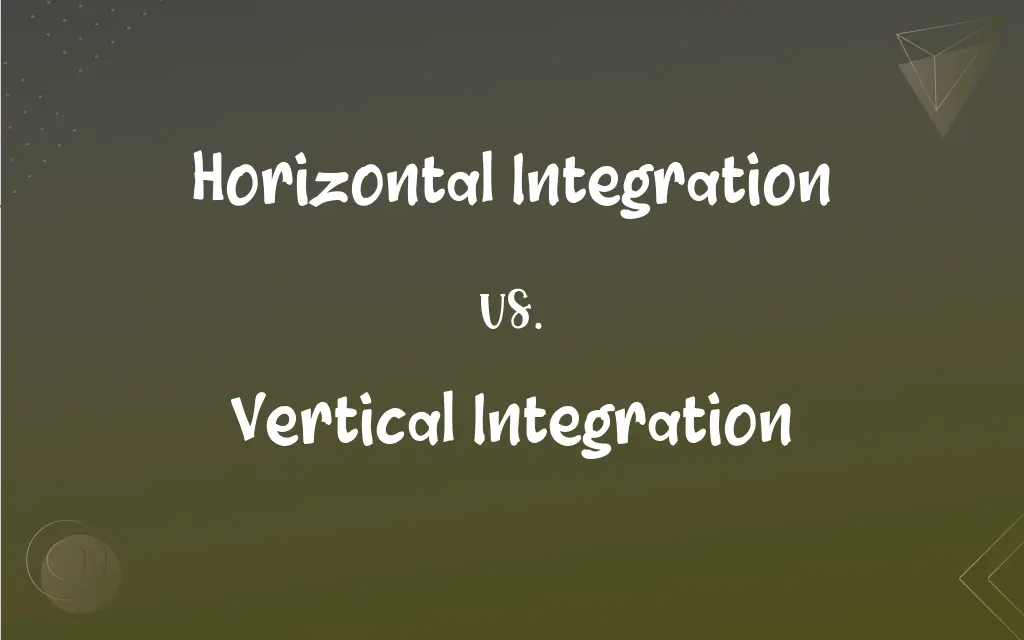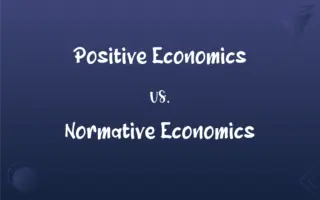Horizontal Integration vs. Vertical Integration: What's the Difference?
Edited by Aimie Carlson || By Harlon Moss || Updated on October 16, 2023
Horizontal integration involves acquiring or merging with competitors in the same industry. Vertical integration involves controlling multiple stages of the production or supply chain.

Key Differences
Horizontal integration is a business strategy where a company acquires, merges with, or creates alliances with its competitors, essentially consolidating its position in the same stage of the industry. Vertical integration, conversely, is where a company takes control over multiple stages of its product or service's supply chain, aiming to achieve cost efficiencies and greater market control.
For instance, if a coffee shop chain decided to buy out another coffee shop chain, that would be an example of horizontal integration. However, if the same coffee shop chain decided to buy a coffee bean farm or a milk dairy farm, that would exemplify vertical integration.
The primary objective behind horizontal integration is to enhance market share, reduce competition, and achieve economies of scale. On the other hand, vertical integration is driven by the desire to gain better control over the supply chain, reduce costs, and ensure a consistent quality or supply of key inputs.
When businesses opt for horizontal integration, they're looking to diversify their products or services but within the same sector. Vertical integration is less about diversification and more about deepening the company's role in its primary industry, by moving backward (towards suppliers) or forward (towards consumers) in the supply chain.
Companies considering horizontal integration often face regulatory scrutiny due to antitrust concerns, as it can reduce competition in the industry. In contrast, vertical integration can sometimes sidestep these regulatory issues, though it comes with the challenge of managing diverse operations.
ADVERTISEMENT
Comparison Chart
Definition
Merging with firms in the same industry stage.
Taking control of multiple production supply stages.
Objective
Increase market share, reduce competition.
Control over supply chain, cost efficiencies.
Direction
Expands at the same level of the value chain.
Expands up or down the value chain.
Example
One car manufacturer buying another.
Car manufacturer buying a tire company.
Regulatory Concerns
Potential antitrust issues.
Managing diverse operations.
ADVERTISEMENT
Horizontal Integration and Vertical Integration Definitions
Horizontal Integration
Horizontal integration aims to achieve economies of scale.
Several small bookstores merging to challenge a big chain is horizontal integration.
Vertical Integration
Vertical integration means controlling different stages of production or distribution.
A shoe brand buying a leather processing plant is vertical integration.
Horizontal Integration
It's a strategy to expand market presence by acquiring competitors.
A major soda company buying out a smaller soda brand exemplifies horizontal integration.
Vertical Integration
Vertical integration can be forward (towards the market) or backward (towards suppliers).
A dairy company opening its own retail stores is forward vertical integration.
Horizontal Integration
It involves reducing competition through consolidations.
When streaming services merge to offer a larger content library, it's horizontal integration.
Vertical Integration
Vertical integration deepens a company's role in its primary industry.
A publisher owning a printing press and bookstores is vertically integrated.
Horizontal Integration
Horizontal integration is the merger of companies at the same stage of production.
Two tech companies merging to dominate the software market is horizontal integration.
Vertical Integration
It seeks to achieve consistency and reduce costs.
A coffee chain owning its coffee farms employs vertical integration.
Horizontal Integration
Horizontal integration diversifies offerings within the same sector.
A cosmetics company acquiring another makeup brand is engaging in horizontal integration.
Vertical Integration
It's a strategy to enhance control over the supply chain.
An automobile company owning its parts production units showcases vertical integration.
FAQs
Why do companies opt for horizontal integration?
They aim to increase market share, reduce competition, and achieve economies of scale.
What is horizontal integration?
Horizontal integration involves companies merging or acquiring others at the same production stage.
What are the benefits of vertical integration?
It offers better supply chain control, cost reductions, and consistent product quality.
What's an example of backward vertical integration?
A clothing brand buying a cotton farm.
How does vertical integration differ from horizontal integration?
Vertical integration controls multiple supply chain stages, while horizontal integrates within one stage.
Why might vertical integration be risky?
Managing diverse operations can be challenging and might divert focus from core activities.
Can vertical integration make a company self-sufficient?
Partially, as it can control raw material to final product, but external factors always play a role.
Is horizontal integration similar to diversification?
Partially, but it's about expanding within the same industry sector, not different sectors.
Can horizontal integration lead to monopolies?
Potentially, if one company becomes overly dominant, raising antitrust concerns.
What's a drawback of horizontal integration?
Reduced competition can lead to less innovation and higher prices for consumers.
How does vertical integration impact suppliers?
It can reduce dependency on external suppliers, impacting their business.
Are there regulatory concerns with both horizontal and vertical integration?
Horizontal faces antitrust issues, while vertical can sometimes avoid these but must manage diverse operations.
Can a company pursue both horizontal and vertical integration?
Yes, some companies use both strategies to diversify and control their supply chain.
Is horizontal integration common in the tech industry?
Yes, tech companies often merge or acquire others to expand product offerings and market presence.
Do consumers benefit from horizontal integration?
They might enjoy broader product ranges, but less competition might mean higher prices.
Does horizontal integration always lead to market dominance?
Not always, but it can enhance a company's position in the market.
How does vertical integration affect consumers?
It can lead to consistent quality and potentially lower prices due to cost efficiencies.
Does horizontal integration affect product variety?
It can, especially if competing products are merged or phased out.
Is vertical integration more common in certain industries?
Yes, industries like energy and automobiles often use vertical integration for supply chain control.
How can companies balance the challenges of vertical integration?
By maintaining a strong focus on core competencies and managing diversified segments effectively.
About Author
Written by
Harlon MossHarlon is a seasoned quality moderator and accomplished content writer for Difference Wiki. An alumnus of the prestigious University of California, he earned his degree in Computer Science. Leveraging his academic background, Harlon brings a meticulous and informed perspective to his work, ensuring content accuracy and excellence.
Edited by
Aimie CarlsonAimie Carlson, holding a master's degree in English literature, is a fervent English language enthusiast. She lends her writing talents to Difference Wiki, a prominent website that specializes in comparisons, offering readers insightful analyses that both captivate and inform.































































